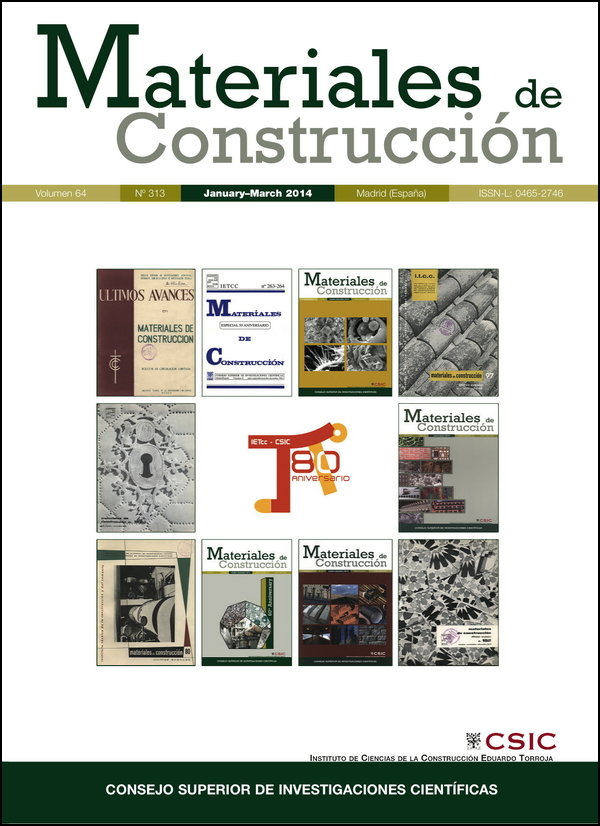Estudio experimental del comportamiento de una fábrica sometida a cargas explosivas
DOI:
https://doi.org/10.3989/mc.2014.01513Palabras clave:
Ladrillo, Aceleración, Deformación, Resistencia a la compresiónResumen
Con el reto que supone proteger a la nación contra atentados terroristas se ha visto acrecentada la importancia de conocer el comportamiento de materiales de construcción cuando se someten a una carga explosiva. Al contrario de la mayoría de los materiales, las fábricas de ladrillo ofrecen poca resistencia a dichas cargas. En el presente trabajo, se estudió el comportamiento de una fábrica de ladrillo ante cargas explosivas colocadas a diferentes distancias del muro. Se realizaron seis pruebas con explosivos de potencias distintas y a diferentes distancias. Se trazaron las curvas presión-tiempo y aceleración-tiempo, midiéndose asimismo la deformación en un punto concreto. Los valores experimentales de las curvas presión-tiempo y aceleración-tiempo se compararon con los que se calcularon con la ayuda de la aplicación informática ConWep a fin de establecer las correlaciones entre ambos conjuntos de resultados. También se compararon los resultados experimentales obtenidos con los publicados por otros investigadores. Estas correlaciones podrían contribuir a mejorar el conocimiento del comportamiento de estructuras de fábrica sometidas a cargas explosivas.
Descargas
Citas
1. Fischer, K.; Riedel, W.; Ziehm, J. (2011) Full-scale validation of a blast-proof masonry wall system and assessment of coupling effects using a TDOF model. 14th International Symposium on Interaction of the Effects of Munitions with Structures- ISIEMS.
2. Ehsani, M.R.; Saadatmanesh H.; Velazquez-Dimas, J.I. (1999) Behavior of retrofitted URM walls under simulated earthquake loading. J. Compos. Constr, 3 [3], 134–142. http://dx.doi.org/10.1061/(ASCE)1090-0268(1999)3:3(134)
3. Varma, R.K.; Tomar, C.P.S.; Parkash, S.; Sethi, V.S. (1996) Damage to brick masonry panel walls under high explosive detonations. ASME-Publications-PVP, 351, 207–216.
4. Casadei, P.; Agneloni, E. (2010) Elastic systems for dynamic retrofitting (ESDR) of structures. 1st International Conference of Protective Structures (ICPS), Manchester, UK.
5. Ward, S.P. (2008) Retrofitting walls to resist blast loads. 20th International Symposium on Military Aspects of Blast and Shock, Oslo, Norway.
6. Wei, X.Y.; Huang, T.; Li, N. (2012) Numerical Derivation of Pressure-Impulse Diagrams for Unreinforced Brick Masonry Walls. Adv Mater Res Zug, 368/373, 1435–1439, 4th International conference Technology of architecture and structure.
7. Wu, C.; Hao, H. (2007) Numerical simulation of structural response and damage to simultaneous ground shock and air blast loads. Int j impact eng, 34 [3], 556–572. http://dx.doi.org/10.1016/j.ijimpeng.2005.11.003
8. Godinho, J.; Agnew, E.I.; Marjanishvilli, S. (2007) Resistance of Historic Unreinforced Masonry Walls to Air-Blast Loads. SO: Structure, 20–22.
9. Ngo, T.; Mendis, P.; Gupta, A.; Ramsay, J. (2007) Blast loading and blast effects on structures, An overview. Electron J Struct Eng, 7, 76–91.
10. Urgessa, G.S.; Maji, A.K. (2009) Dynamic Response of Retrofitted Masonry Walls for Blast Loading. J Eng Mech, 136 [7], 858–864. http://dx.doi.org/10.1061/(ASCE)EM.1943-7889.0000128
11. Wei, X.; Stewart, M.G. (2010) Model validation and parametric study on the blast response of unreinforced brick masonry walls. Int J Impact Eng, 37 [11], 1150–1159. http://dx.doi.org/10.1016/j.ijimpeng.2010.04.003
12. Sorensen, A.; McGill, W.L. (2011) What to look for in the aftermath of an explosion? A review of blast scene damage observables. Eng Fail Anal, 18 [3], 836–845. http://dx.doi.org/10.1016/j.engfailanal.2010.12.010
13. Brode, H.L. (1955) Numerical solutions of spherical blast waves. J Appl Phys, 26 [6], 766–775. http://dx.doi.org/10.1063/1.1722085
14. Henrych, J.; Major, R. (1979) The dynamics of explosion and its use. Elsevier scientific publishing company, New York.
15. Smith, P.D.; Hetherington, J.G. (1994) Blast and ballistic loading of structures. Butterworth-Heinemann Oxford, UK.
16. Formby, S.A.; Wharton, R.K. (1996) Blast characteristics and TNT equivalence values for some commercial explosives detonated at ground level, J Hazard Mater, 50 [2], 183–198. http://dx.doi.org/10.1016/0304-3894(96)01791-8
17. ConWep: Conventional weapons Effects Program. (2005) Version 2.1.0.8 U.S. Army Vicksburg, MS USA.
18. UFC: Structures to Resist the Effects of Accidental Explosions. (2008) Unified Facilities Criteria (UFC) 3-340–02.
19. AASTP: Manual of NATO Safety Principles for the Storage of Military Ammunition and Explosives, (2010). Edition 1, Change 3, Allied Ammunition Storage and Transport Publication.
20. Brode, H.L. (1959) Blast wave from a spherical charge. Physics of fluids, 2 [2], 217–229. http://dx.doi.org/10.1063/1.1705911
21. Brode, H.L. (1968) Review of nuclear weapons effects. Annual review of nuclear science, 18 [1], 153–202. http://dx.doi.org/10.1146/annurev.ns.18.120168.001101
22. Wu, C.; Hao, H. (2005) Modeling of simultaneous ground shock and airblast pressure on nearby structures from surface explosions. International journal of impact engineering, 31 [6], 699–717. http://dx.doi.org/10.1016/j.ijimpeng.2004.03.002
23. Siddiqui, J.I.; Ahmad, S. (2007) Impulsive loading on a concrete structure. Proc. of the Institution of Civil Engineers. Structures and buildings, 160 [4], 231–241. http://dx.doi.org/10.1680/stbu.2007.160.4.231
24. Ahmad, S.; Elahi, A.; Iqbal, J.; Keyani, M.A.; Rahman, A.G.A. (2012) Impulsive loading on reinforced concrete wall. Proc. of the Institution of Civil Engineers. Structures and buildings. 166 [3], 153–162. http://dx.doi.org/10.1680/stbu.11.00008
Publicado
Cómo citar
Número
Sección
Licencia
Derechos de autor 2014 Consejo Superior de Investigaciones Científicas (CSIC)

Esta obra está bajo una licencia internacional Creative Commons Atribución 4.0.
© CSIC. Los originales publicados en las ediciones impresa y electrónica de esta Revista son propiedad del Consejo Superior de Investigaciones Científicas, siendo necesario citar la procedencia en cualquier reproducción parcial o total.
Salvo indicación contraria, todos los contenidos de la edición electrónica se distribuyen bajo una licencia de uso y distribución “Creative Commons Reconocimiento 4.0 Internacional ” (CC BY 4.0). Consulte la versión informativa y el texto legal de la licencia. Esta circunstancia ha de hacerse constar expresamente de esta forma cuando sea necesario.
No se autoriza el depósito en repositorios, páginas web personales o similares de cualquier otra versión distinta a la publicada por el editor.
















